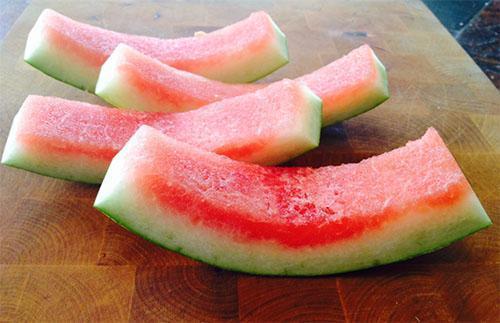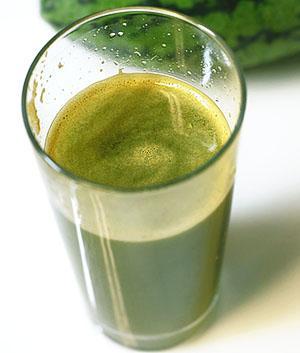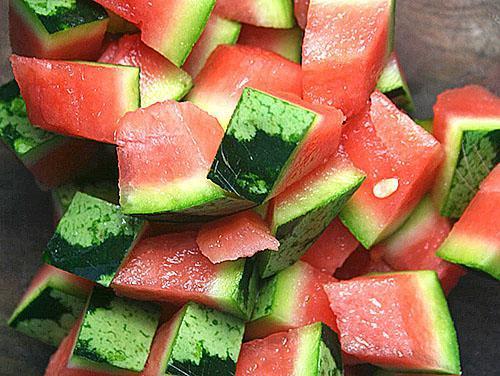The benefits and harms of eating watermelon peels
 Many people believe that the main value of watermelon is the scarlet juicy pulp, which is so loved by both little sweet tooths and adults. Despite the fact that the main component of watermelon is water, the fruits, under the green crust, contain up to 13% sugars, dietary fiber and pectins, proteins, organic and amino acids. The sweet pulp of watermelon contains a number of vitamins and macronutrients important for the human body, antioxidants and other beneficial substances.
Many people believe that the main value of watermelon is the scarlet juicy pulp, which is so loved by both little sweet tooths and adults. Despite the fact that the main component of watermelon is water, the fruits, under the green crust, contain up to 13% sugars, dietary fiber and pectins, proteins, organic and amino acids. The sweet pulp of watermelon contains a number of vitamins and macronutrients important for the human body, antioxidants and other beneficial substances.
At the same time, most consumers of this giant berry either forget or do not know about the properties and benefits of watermelon peels (see. recipe for watermelon peel jam). But practically all the bioactive substances found in the pulp are in this part of the watermelon. There is less moisture and sugar in the crusts, but much more fiber and chlorophyll, amino acids and some other active components.
While eating watermelon, you do not need to rush and throw away the remaining peels, which are used in folk medicine as an excellent diuretic, cleansing, analgesic, choleretic and expectorant.
In traditional medicine recipes, peels are used to prepare juices, infusions and decoctions, and both raw and dried peels have a healing effect, which are easy to store and use throughout the year.
The use of raw watermelon peels in folk medicine

 Moisture, amino acids, vitamins and microelements in the composition of fresh watermelon peel are an excellent tool for maintaining the beauty of the skin. Gruel made from such plant materials:
Moisture, amino acids, vitamins and microelements in the composition of fresh watermelon peel are an excellent tool for maintaining the beauty of the skin. Gruel made from such plant materials:
- actively moisturizes;
- regulates the sebaceous glands;
- has a mild anti-inflammatory effect;
- relieves swelling and tones.
Watermelon peels are useful in the treatment of digestive disorders, in particular, peel-based products are included in therapy for colitis, dysbacteriosis and dyspepsia in adults and young patients.
As a remedy, folk medicine suggests making decoctions and infusions from watermelon peels.
Watermelon peel decoction
 Patients suffering from obesity, kidney and stomach diseases can feel the tangible benefits of watermelon peels if they take half a glass of fresh broth three times a day.
Patients suffering from obesity, kidney and stomach diseases can feel the tangible benefits of watermelon peels if they take half a glass of fresh broth three times a day.
A liter of water is required per 100 grams of crushed peeled watermelon rinds. The mixture is kept on low heat for about half an hour, after which the agent is insisted for about an hour, filtered and cooled.
Infusion of watermelon peels
 With spasmodic stomach pains, diseases of the biliary tract and liver, excess weight and inflammatory diseases of the urinary sphere, traditional medicine recommends taking watermelon peels as an infusion.
With spasmodic stomach pains, diseases of the biliary tract and liver, excess weight and inflammatory diseases of the urinary sphere, traditional medicine recommends taking watermelon peels as an infusion.
To make it, the crushed watermelon peels are dried, and then poured with boiling water at the rate of 500 ml of boiling water per 80 grams of raw or two tablespoons of dry crushed watermelon peels.The agent is infused and filtered, after which 80 ml of watermelon infusion is taken three times a day before meals.
How to dry watermelon rinds?
 Dried watermelon rind retains all active ingredients and has a beneficial effect on gastrointestinal disorders, constipation and inflammatory processes in the digestive system.
Dried watermelon rind retains all active ingredients and has a beneficial effect on gastrointestinal disorders, constipation and inflammatory processes in the digestive system.
The herbal preparation can be taken in the form of a powder mixed with honey, or in the form of decoctions, to which other herbs, for example, calendula, calamus and yarrow, are added for greater benefit.
For medicinal purposes, a dense white part of the crust is used. Before you dry watermelon peels or make decoctions and infusions from fresh raw materials, first remove the solid colored layer.
 Then the crusts are cut into thin elongated plates, convenient for laying in an electric dryer or on baking sheets. Watermelon peels are dried at 55–60 ° C until the raw material completely loses moisture, when the pieces of peels become light and brittle.
Then the crusts are cut into thin elongated plates, convenient for laying in an electric dryer or on baking sheets. Watermelon peels are dried at 55–60 ° C until the raw material completely loses moisture, when the pieces of peels become light and brittle.
When drying, it is important not to allow the temperature to rise so that the benefits of the watermelon rind are kept at the highest possible level.
Contraindications and possible harm from beneficial watermelon peels
 Since harmful substances, for example, heavy metals and nitrates, can accumulate in the surface layers of melons, with the existing benefits, harm from watermelon peels cannot be ruled out either. To avoid the negative effects of herbal products, only high-quality, safe for humans are taken watermelonsgrown in compliance with all the rules of agricultural technology.
Since harmful substances, for example, heavy metals and nitrates, can accumulate in the surface layers of melons, with the existing benefits, harm from watermelon peels cannot be ruled out either. To avoid the negative effects of herbal products, only high-quality, safe for humans are taken watermelonsgrown in compliance with all the rules of agricultural technology.
You can insure yourself and remove nitrates from the crusts by soaking the peeled pieces for 2-3 hours in clean cold water.
During this time, most of the toxic substances pass into moisture, and the crusts can be used to prepare decoctions, candied fruits and jams, and also dry after removing traces of water. The beneficial properties of plant materials are preserved if candied fruits are prepared from the peels. However, healthy watermelon peels are harmful to everyone who suffers from diabetes or wants to lose weight.
But with renal colic, painful sensations in the stomach, ailments associated with the pancreas, with gout and a number of other diseases, candied fruits will be a good addition to the menu. Funds based on watermelon peels are also harmful to those who are prone to diarrhea and suffer from urolithiasis. Damage to the health of the crust can also occur during exacerbation of chronic diseases of the gastrointestinal tract.